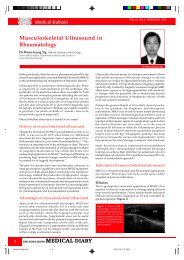Dermatology - 香港醫學組織聯會
Dermatology - 香港醫學組織聯會
Dermatology - 香港醫學組織聯會
You also want an ePaper? Increase the reach of your titles
YUMPU automatically turns print PDFs into web optimized ePapers that Google loves.
VOL.15 NO.11 NOVEMBER 2010<br />
Is Psoriasis a Cutaneous Disease or<br />
Systemic Disease?<br />
Dr. LY CHONG<br />
MBBS(HK), FRCP(Lond, Edin, Glasg), FHKCP, FHKAM(Med)<br />
Private Dermatologist<br />
Psoriasis is a well known chronic, non-contagious skin<br />
disorder since ancient times. The word “Psora” is a<br />
Greek word meaning “To itch”. It is notorious for its<br />
chronicity in its natural course and difficulties in the<br />
management. Although great efforts have been tried in<br />
medical researches for decades, it is still not curable and<br />
its exact aetiology remains unknown.<br />
Prevalence in Chinese<br />
In Western literature, it is well reported that 1-3% of<br />
the Caucasian population have psoriasis. Though it<br />
is a common skin disease, the prevalence reported in<br />
Chinese is lower than that of Caucasians. From the<br />
limited resources available, it is estimated that psoriasis<br />
occurs in about 0.1-0.3% of the Chinese population. 1<br />
In 1984, a nation-wide screening of psoriasis had been<br />
conducted in 24 regions (53 centres) of China, involving<br />
a coverage of 6,617,917 population. About 11,393 cases of<br />
psoriasis (0.123% among the population studied; range<br />
from 0.3%) had been reported. Interestingly,<br />
the prevalence is highest in the Northeast provinces<br />
and lowest in the Southern ones where there is more<br />
sunshine. It is also higher in cities than the villages.<br />
In Hong Kong, the prevalence is estimated to be<br />
approximately 0.3% of the total population. 2 It is the 5th<br />
leading new cases of skin disorders in public dermatology<br />
clinics, with more than 600 new cases annually.<br />
Immuno-pathogenesis of Psoriasis<br />
Despite its unknown aetiology, there have been<br />
breakthroughs in the understanding of the immunopathogenesis<br />
of psoriasis in recent years. It is now<br />
almost certain that psoriasis is a T-lymphocyte mediated<br />
inflammatory dermatosis with hyper-proliferation<br />
of keratinocytes in genetically predisposed subjects<br />
(Diagram 1). It is regarded as one form of immunemediated<br />
inflammatory diseases (IMID), which is a term<br />
designated for organ-specific diseases in which cells and<br />
cytokines of the adaptive immune system cause tissue<br />
inflammation or destruction.<br />
Until recent years, it was believed that IMID was<br />
either mediated by Th1 T-cells (which is stimulated<br />
by IL-12) or TH2 T-cells. The former subset includes<br />
psoriasis, rheumatoid arthritis, multiple sclerosis<br />
and inflammatory bowel diseases, while the latter<br />
subset includes atopic dermatitis and asthma. A new<br />
Medical Bulletin<br />
Dr. LY CHONG<br />
pathogenic concept in IMID however is developed upon<br />
the discovery of a new T-cell lineage in 2005. This new<br />
cell lineage is called Th17 T-cell, which is defined by the<br />
production of IL-17, and stimulated by IL-23. This subset<br />
likely includes psoriasis, rheumatoid arthritis, multiple<br />
sclerosis and inflammatory bowel diseases. IL-12 and IL-<br />
23 are structurally related with a common 40kD subunit<br />
(p40), which leads to the development of a new group of<br />
biologics called anti-P40 (anti-IL12/23) that blocks both<br />
the Th1 and Th17 pathways.<br />
Diagram 1. Postulated Immuno-pathogenesis of Psoriasis<br />
Co-morbidities of Psoriasis<br />
The traditional belief about psoriasis is that it is a<br />
cutaneous disease without visceral involvements, albeit<br />
10-30% of the patients have joint involvements. This<br />
concept is challenged in recent few years when more and<br />
more systemic co-morbidities had been reported. When<br />
the term “psoriasis and co-morbidities” is searched in<br />
Medline, more than 200 articles can be retrieved over<br />
the past two decades. It is one of the hottest research<br />
topics in dermatology in the past 5 years, as shown by<br />
the numerous publications from different countries and<br />
different indexed journals. The possible co-morbidities<br />
of psoriasis reported in literatures are summarised in<br />
Table 1. Three important areas which may have impacts<br />
on medical health are worth mentioning here.<br />
Cardiovascular diseases (hypertension, myocardial infarction),<br />
cerebrovascular and peripheral vascular diseases<br />
Metabolic syndrome (obesity, diabetes mellitus)<br />
Non-alcoholic fatty liver<br />
Autoimmune diseases (Crohn’s disease, ulcerative colitis, multiple sclerosis)<br />
Lymphoma, melanoma, non-melanoma skin cancers<br />
Depression, suicide<br />
Smoking, alcoholism<br />
Osteoporosis<br />
Table 1. Possible co-morbidities of psoriasis reported in literatures<br />
9
















